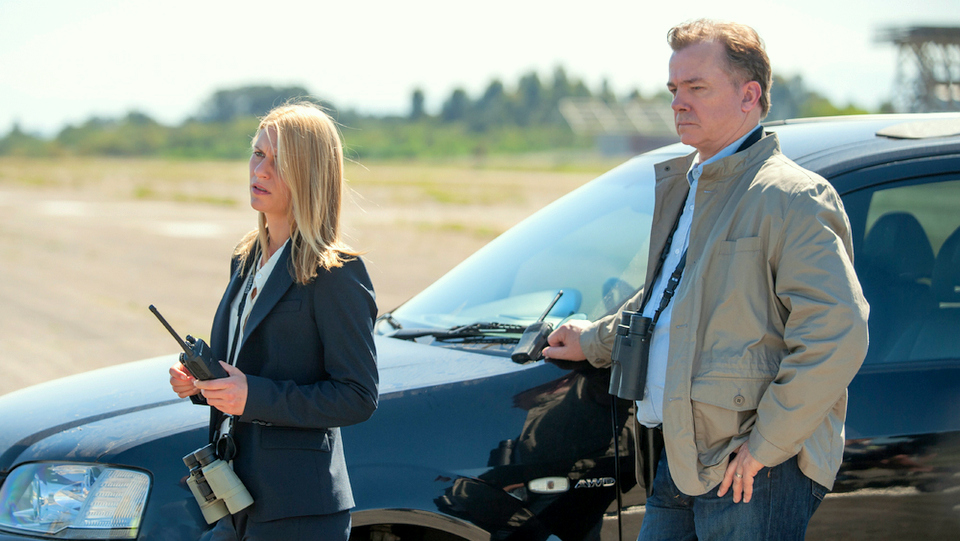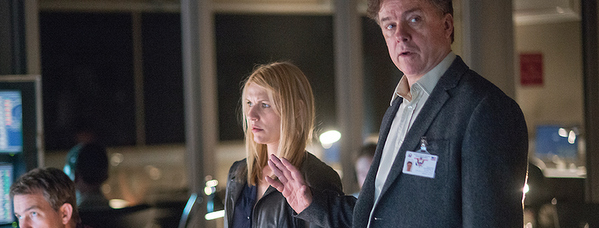
Michael O’Keefe and Claire Danes on the set of “Homeland.” Photograph by David Bloomer/Showtime.
Michael O’Keefe says acting is a lot like meditation: both ask you to give yourself over completely to what is going on.
The first day I came to work with Claire Danes on the set of season four of Homeland, it was immediately clear to me that all of Danes’ accolades and awards were well deserved. Her persona is lucid, grounded, and empowered at the highest level. And for the first time in a long time I had the feeling that I needed to raise my usual game plan to another level. Frankly, she kind of scared me. So strong was the power of her focus that I had a real moment of gut check that felt something like, “Hey, are we ready? Because she sure as hell is.” After the initial shock I saw this for what it really was: an excellent opportunity to approach my work mindfully.
I learned as much about mindfulness from Claire Danes as I have from any teacher, though we didn’t discuss mindfulness at all.
Our characters were initially hostile and suspicious of each other. On set, I was the newcomer on her turf, but ironically in the show she was the newcomer coming on to my turf. The intensity of our interaction allowed me to capitalize on my initial fear and substitute it for the conflict that needed to arise between us. As our characters became more familiar with each other they grudgingly formed an alliance that served the needs of the story and gave Claire and me a chance to have some fun together. Believe me when I tell you that giving yourself over to Claire Danes in a scene is as close to a transcendent experience as an actor can have. Like a wire walker performing without a net, she risks everything, and any savvy actor can essentially follow her lead to a wonderful outcome.
I learned as much about mindfulness from her as I have from any teacher, though she and I never discussed mindfulness at all. We didn’t have to. She was supremely mindful in her approach and that mindfulness was pervasive.

Claire Danes as Carrie Mathison and Michael O’Keefe as John Redmond in Homeland (Season 4, Episode 6). – Photo: David Bloomer/SHOWTIME – Photo ID: Homeland_406_0209.R
What Good Acting Requires
The characteristics of good acting vary among actors and with the demands of their characters. Yet some characteristics, while not universal, are usually evident in what we refer to as “good work.” Clarity is high on the list. Poise, insight, humor, passion, and dignity are most definitely in the mix. And a sometimes underrated skill is also necessary: the ability to listen really well. That’s because a good deal of what actors do is react to other actors or situations. When we practice listening with genuine depth and conviction we find truly marvelous moments. And audiences are drawn in by the silent awareness that listening creates.
In a sense, anyone who can read well can imagine how a scene should be played. Good writing sparks the imagination, and if you’re a good reader you can imagine the characters, setting, and plot of a good script. Some of the most fun I’ve ever had as an actor has happened when I’ve been reading a script for the first time. It all plays out like a movie I’ve directed where I also starred in all the parts. Who wouldn’t enjoy their version of that? But bringing scenes to life is an entirely different matter. Assuming you have the talent—and frankly that’s a chimerical thing that can’t be learned but, if possessed, can be clarified—one way to approach acting is to be organized. By “organized” I mean that every nanosecond has to be connected to a larger arc of the character’s progression through the story, and it must appear spontaneously, with compelling verisimilitude, or the audience won’t be interested in what you’re offering.
While working with Robert Duval in The Great Santini, I had some very demanding emotional scenes to fulfill. The central conflict of the film is an exploration of a warrior without a war and the family he takes that out on. I played the role of the teenage son, Ben, who tries to navigate the complicated, sometimes humiliating, relationship with his father while attending a new school in a new town. You can’t just bring tears or passion to this type of work. You have to root it firmly in the arc of the story and connect it to the lifetime preceding the crisis being portrayed. If you don’t organize all of that, you risk falling into the trap of a merely generalized feeling, a surefire way to lose your audience. Specificity, fluidity, and precise calculation have to fuel your foundation as you spontaneously act in the moment.
Reassembling Your Emotions
Take a look at the characteristics listed above: clarity, spontaneity, verisimilitude, poise, and skillful listening. Those are exactly what mindfulness engenders and why practicing it can deepen an actor’s awareness and inform his or her work.
The practice of self-observation and inquiry leads not only to an informed self but to a self that can be forgotten. And it is in this forgetting that actors imbue performances with that subtle something that corrals an audience and leads them where we want them to go.
In meditation, we suspend our everyday engagement with ourselves and the world around us, and engage in an entirely different way. We pay attention. We really pay attention. We practice paying attention. We notice every breath, feeling, and thought. We see them arise, reveal, and fade away. And the more we practice this kind of self-engagement the more informed we are about ourselves and the world around us. And, if we’re fortunate, we begin to realize that nothing separates us from others, and the entire universe, but how we engage with ourselves.
By cultivating a mindfulness practice I give myself a much better chance at developing the insight necessary to understand the self and the art of acting. If, for instance, while meditating I notice some experience, or some memory, that relates to a character’s experience, I can begin to internally substitute my experience for the character’s. That personal reality can infuse the imaginary reality of the scene. Bring enough of that to your performance and people will think you are that character.
Practicing that kind of substitution can only happen when the feelings you access are malleable, pliable, and can be shaped to fit the needs of a scene. You have to be able to not only separate out the moment–to–moment aspects of the feeling, but also allow it to reassemble as a feeling of the character one is portraying. But it takes a lot of practice. It doesn’t just happen, although it appears that way to the audience.
For the National Tour of Aaron Sorkin’s A Few Good Men, I played Lieutenant Kaffee, the military lawyer who transforms from someone half-heartedly doing just enough to get by in his work to an impassioned advocate who is taking on an entrenched and aggressive authoritarian culture, and risking his career and more to do so. I had to carry a three-hour performance and do most of the heavy lifting. The energy required to do theater is immense, and without a grounded meditation practice I’m certain I would have walked off the stage into the orchestra pit for lack of concentration. Besides that, the fun of acting for extended periods of time while performing the same material eight times a week for several weeks is discovering how each moment is unique and liberated, though essentially repetitive every day. The routine takes on an aspect of ritual, and like a trusted prayer you return to it every time with fresh eyes, if you are prepared to do so.
In order to get to this place you have to have the capacity to be not only your best self, but to forget that self entirely and momentarily become another—the character’s self. No small feat, that.
Discipline Plays a Role
This isn’t to say that all great actors consciously engage in mindfulness practice, but it’s clear they embody characteristics that mindfulness engenders. For those of us who are not great actors, and I number myself among them, we must approach things with discipline—and it does little good to try to adhere to one that you don’t practice on a daily basis.
Experienced meditators have usually had the experience during extended retreats that, when sitting, what initially took an hour, or a day, can begin to come much more quickly. That’s one reason why, if we are to bring mindfulness to acting, or any art form, the practice must be daily, and disciplined. Without that foundation an actor can be pushed this way and that by the currents that blow every which way on a set.
Once I’ve established my backstory, made choices about my character, and received instruction from the director, the only thing I have to work with is my fellow actors. They become, if not my primary focus, then the object of my performance’s focus, because without them nothing is going to happen, and with them, it all comes together. What better way to ensure that than developing a mindfulness practice that allows you to include, embrace, and empower others while you work together?
Mindfulness allows us to take care of ourselves so thoroughly that we have no more need to be concerned about ourselves. In acting, that kind of awareness fosters an environment where the other actors are set free to be who they want to be in the piece. That’s when magic becomes possible. If a shared vision of good material is recorded, you create an event that has what it takes to find an audience.
In the end we are servants of the stories we want to tell. On the rare occasion that one has the opportunity to tell a good story, it takes not just a good actor, but a free one, to convey the story’s intimacies. Being intimate with oneself, and others, is the key. It unlocks the gates of beauty, which can then flow freely through us, and the stories we long to tell.
Finding Your Self
(A practice for actors and anybody else)
1. Start by meditating for 15 minutes (or more).
2. Check in with yourself. Contemplate “who you are”: your birthplace, your family, education, etc. Contemplate “how you feel” about your current life, its ups and downs, and your feelings about what’s going on in your life.
3. Meditate again for 5 minutes.
4. Survey the information. Ask yourself, “Am I these contemplated items, or is there more?” Consider that all of the above is a story, and it accrues meaning through the attention you give it.
5. Can you see through that story and experience yourself as something less solid, more transparent, and, in the end, abiding nowhere special, always right here, not caught between the past or future?
5. Rest in that understanding for a little while. That’s what some would call your “true self” or “who you really are.” It doesn’t need constant maintenance and it’s no big deal.
If you’re an actor, and you become awake to how fluid the self is, you could be anybody, over and over again. If you’re not an actor, and you step into the flow of “self,” you could be anyone, anywhere, anytime.
This article originates from Mindful. Mindful Magazine Aug. 15

